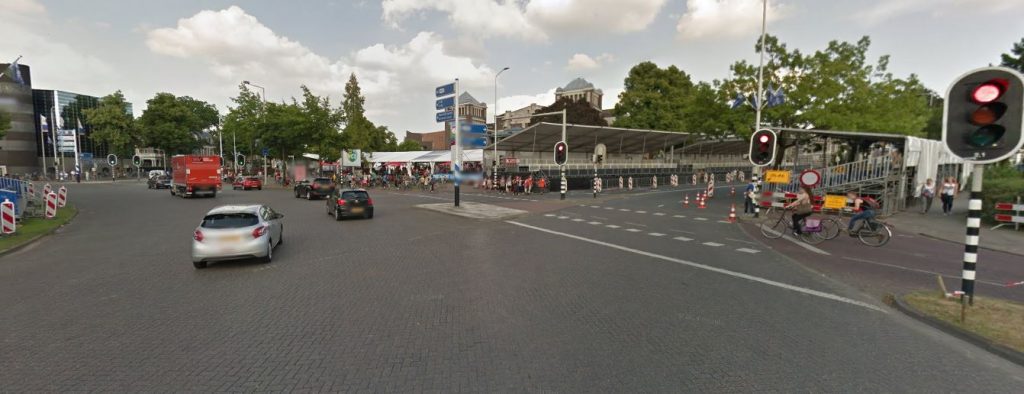My Dutch cycling adventures continued with a visit to see two cities that are only ~18km apart and working hard to improve their cycling provision even further (do they ever stop…?). Arnhem and Nijmegen both have about 150,000 people each, in the southeast of The Netherlands. Within both cities there is plenty going on, but now they are also looking at how they connect between the cities better.
-1024x559.jpg)
“Fast cycle highways” or “fietssnelwegen“ are a relatively recent addition to the cycling bag of tricks in The Netherlands. They aim to make it easier to connect longer-distance destinations by more direct means. My host lived in Nijmegen and commuted daily by bike to Arnhem for work, but even he was considered fairly unusual by his colleagues for making that kind of long trip (many would probably take the excellent train service). Having grown their “local” cycle trips so successfully, this is one way of increasing their numbers even further – make it easier to do the trips of 10km, 20km or further by bike. This could also include cycle touring trips or training rides that we’re very used to in New Zealand (although if you’re not necessarily after the most direct route, there’s already a very useful network of friendly routes using “knooppunt“ marker points around The Netherlands). With the growing use of electric bikes (aka “e-bikes” or “pedelecs”) in The Netherlands, these kinds of distances are also easily within their range (let’s not forget how much the Dutch use motor-scooters on these routes too). In many cases, existing cycling routes existed but were of a lesser quality, i.e. narrow widths, poor road crossings, indirect. The route between Arnhem and Nijmegen is being developed into the “Rijnwaalpad” (“Rhine-Waal Path”, named for the two main rivers crossed) and features a fairly consistent 3-4m wide cycleway and a number of new bridges and underpasses (including the ridiculously long “Snelbinder” bridge near Nijmegen). Total cost of this route: 17 million Euros (~NZ$27m).
-1024x524.jpg)
Where the pathway crossed the road directly, typically the cycleway would have priority and this might be reinforced by using a raised platform. It’s important to remember too that most minor rural roads in the Netherlands have speed limits of only 60-80km/h, which changes the environment faced as well.
-1024x512.jpg)
There was even an effort to make the route more interesting. At one underpass, there were some unusual “chainlink” patterns on the walls. It was explained to me that these can light up with different colours and people will be able to use an app to request a particular sequence when they go past! Completely pointless and whimsical but FUN!
-1024x583.jpg)
It’s not just between the cities though. Like elsewhere in the Netherlands, interesting cycling features abound within the two cities, including:
- A grade-separated roundabout in Arnhem for cycling (and walking) completely inside the main traffic roundabout
-1024x524.jpg)
- A “2-minus-1 road” where a narrow roadway is split into a single traffic lane flanked by cycle lanes. It means that by default bikes have a space on the road and cars will have to wait to use it if there is oncoming traffic. (I bet our friend on Dyers Pass Rd would have liked that arrangement there…)
-1024x614.jpg)
- More fietsstraat “bicycle streets” of various designs. I was quite interested in the design in Nijmegen that featured a textured median area; the net effect was that most passing vehicles straddled it to avoid the rough surface, and thus passed you with a reasonable gap.
-1024x569.jpg)
- A very clever six-leg signalised roundabout in Nijmegen featuring a two-way bike path on the outside. I queried whether it was particularly efficient for cycling but, as I soon discovered riding around it myself, the signals are timed so that you can get a wave of green cycle signals if you bike anti-clockwise (the normal roundabout direction in Europe) at the right pace.

A few more pics from my visit:
-1024x524.jpg)
-1024x584.jpg)
-1024x512.jpg)
-1024x626.jpg)
If you like the look of what Arnhem and Nijmegen are doing, then you could come and have a look in 2017 as these cities will be jointly hosting the Velo-City Cycling Conference that year. No doubt many people will be coming to see firsthand just how the Netherlands do what they are famed for! New Zealand is starting to look at better inter-city connections; Napier-Hastings for example is a similar pair of cities that could be linked better by bike. In Christchurch, improvements in getting to Lincoln, Rolleston, Kaiapoi, and the like are slowly being considered too (although not really to the same level as the fietssnelwegen I saw). We’ve still got plenty to do within our cities however and, again, Arnhem and Nijmegen gives us plenty of nice examples of how to do that too.
So what might also work here in New Zealand?

-1200x684.jpg)
Does anyone else salivate like a starving dog when looking at these pictures ?. Thanks for the wonderful post (and series of posts) but in an odd way it is a little cruel. (-: …
Here an example of street calming https://goo.gl/maps/d9iQR in Arnhem. This is the opposite of what is proposed in Northcote http://transportblog.co.nz/2015/06/03/northcote-cycling-outcome/
I’m thinks this could gives the outcome with smoother ride for all, and this is a bus route with a Gigantic aardvark and great library along side.